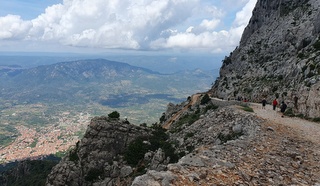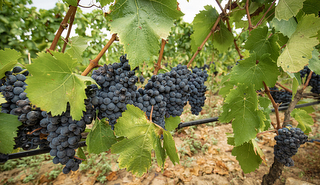Wine is an integral part of Sardinia’s history and economy, with archaeological discoveries pointing to a winemaking heritage dating back at least to Roman times and possibly even the Phoenicians before them. Grapes are grown all over the island and a good quality standard is found from north to south and east to west. There are many native varieties which are not found anywhere else, and some wine experts estimate that there are dozens which are yet to be formally identified. For many decades the international wine media paid little attention to the wines of Sardinia, and production each year was generally consumed by locals and the steady stream of visitors who came to enjoy the island’s incredible beaches and turquoise seas. An enthusiastic younger generation of wine-growers are today revitalizing the reputation of Sardinian wine, with positive progress being made in terms of quality and increased exports abroad. On our Heart of Sardinia tour, we visit a winemaker near Mamoiada called VikeVike, and have the chance to learn about and taste some of Sardinia’s best wines.


Champion Red – Cannonau di Sardegna
The most well-known of the island’s reds is Cannonau di Sardegna. The grape variety Cannonau is in fact the same as the French grenache or the Spanish garnacha. Sardinia was under the rule of the Aragonese for two centuries so it is highly likely that the Spanish introduced the grape to the island. The Cannonau di Sardegna DOC must be made with 90% of this grape and produces full-bodied, fruity wines, usually low in tannins. Cannonau vines are planted all over the island.


Other red varieties to look out for:
Carignano
Carignano is another of the most famous reds in Sardinia, also likely to have been introduced by the Spanish. The Carignano vine makes rich, exuberant wines with noble tannins, and they can age well. It grows predominantly in the south west corner. Carignano del Sulcis has the DOC.
Monica
Among other red grape varieties Monica is very popular, and makes two different DOC wines: Monica di Sardegna and Cagliari Monica. This grape also grows widely across the island and makes wines that are a little lighter than the Cannonau.
Barbera Sarda
Often confused with Barbera Piemontese, Barbera Sarda is a native red grape variety, mainly grown in the central-southern part of Sardinia, which produces a solid, quaffable wine.
Champion White – Vermentino di Gallura
Sardinia takes Vermentino, a grape commonly found across coastal areas of the Mediterranean, and elevates it. The rocky, dry northeast corner of Sardinia, known as Gallura, offers the grape a unique combination of soil, warmth, and sea breezes to make a gloriously honeyed and lively wine. It won Sardinia’s first, and to date, only DOCG classification in 1996.


Other white varieties to look out for:
Nuragus
This is a white grape variety that is particularly common in southern Sardinia, possibly dating back to the days of the Phoenicians. The vine is extremely adaptable and creates a high quality DOC wine.
Nasco
Nasco is a white grape variety that is among the least known varieties today, and is grown almost exclusively in limited areas around Cagliari. It is a very refined grape which in recent years has been rediscovered and repromoted. This too has a DOC appellation.
Vernaccia di Oristano
Grown on Sardinia’s west coast around the town of Oristano, this sherry-like fortified white wine is a truly unique Sardinian experience. It is aged for between three to four years in barrels to make a complex and enigmatic wine, highly prized and rarely found outside of Italy.
Granatza
Another native variety, and arguably less well known outside of the island, Granatza is planted around the area of Mamoiada which we visit on our Sardinia tour, mentioned above. The vines are planted well over 600 metres above sea level in this mountainous area, and Granatza is proving to be a versatile addition to local viticulture, making everything from excellent dessert wines to sparkling wines and classically dry whites.
Sardinian Cuisine
While seafood is popular in the coastal towns, food in the mountains is dominated by meat. The typical carasau flat bread (also known as carta da musica), suckling pig (porceddu) cooked on an open spit and farm-raised lamb are a constant reminder of the pastoral tradition. Herbs such as wild thyme, rosemary, myrtle and juniper are used to flavour meats. The island also produces about 80% of Italy’s pecorino (sheep’s milk cheese), while the most popular goat cheese is caprino. Possibly less appealing to visitors is the infamous casumarzu, a soft creamy cheese packed with live maggots!


